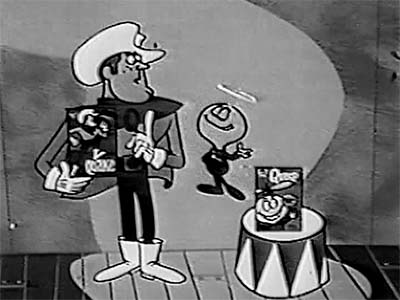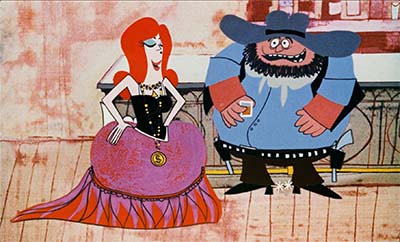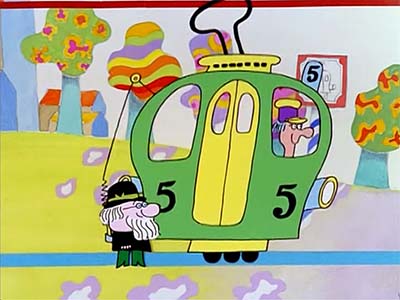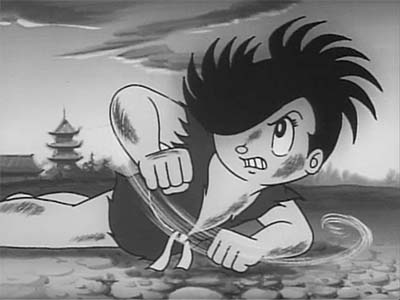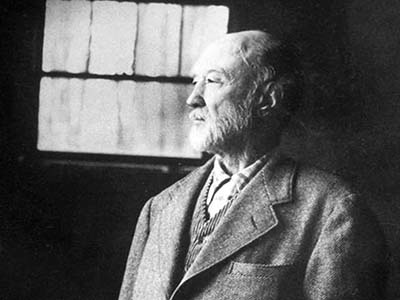YOU MISSED IT! Join now so you won’t miss another great RefPack!

Every other month, Animation Resources shares a new Reference Pack with its members. They consist of e-books packed with high resolution scans video downloads of rare animated films set up for still frame study, as well as podcasts and documentaries— all designed to help you become a better artist. Make sure you download this Reference Pack before it’s updated. When it’s gone, it’s gone!
JOIN TODAY To Access Members Only Content
The latest Animation Resources Reference Pack has been uploaded to the server. Here’s a quick overview of what you’ll find when you log in to the members only page…
Ollie Harrington’s Bootsie![]()
Volume One
Download this article
Ollie Harrington was described by writer Langston Hughes as "America’s greatest African-American cartoonist". Harrington became a well known figure in the Harlem Renaissance of the 1930s largely due to his single panel cartoons for the Amsterdam News under the title, "Dark Laughter". The cartoon featured a character named Bootsie that Harrington described as "a well-fed but soulful character". Bootsie was a typical African American man dealing with life in Harlem. The cartoon often dealt with issues of racial inequality, segregation and poverty.
Harrington’s work is forceful and hard hitting without being didactic. Instead, it’s brutally honest, showing both the good and bad of life as a black man living in pre-Civil Rights era America. His character, Bootsie never spoke out himself or commented on what was going on around him. Instead the people around him revealed themselves by the way that they perceived him. I think you’ll find that a lot of the issues raised in these old cartoons are still a relevant part of our modern lives.
Jay Ward Commercial Reels
![]()
Quisp & Quake / King Vitamin & The Waffle Whiffer
When I was working with Bill Scott at ASIFA, we chatted about his career a bit. He was a storyboard artist at Warner Bros. and U.P.A, and he was a "jack of all trades" at Jay Ward Studios, producing, directing, writing and voicing characters. I asked him what was the most fun to work on, and he admitted that most people know him for his work on The Bullwinkle Show and George of the Jungle, but he enjoyed working on commercials the best of all. They had far fewer limitations due to budget or schedule. The work could all be done in-house. And every one was different.
As you watch these commercials featuring Quisp & Quake, King Vitamin and Wallace The Waffle Whiffer, take note of the format of these spots. They are quite different than most commercials today. They’re structured as little cartoons with a setup of a situation, a brief product shot acting as a commercial within the commercial, and a resolution of the story. The audience watches the commercials the same way they watch the shows they accompany. No one can tune them out, because they are self-contained and entertaining on their own. Cartoon commercials may just be the most delightful form of animation.
JOIN TODAY To Access Members Only Content
West And Soda
![]()
Bruno Bozzetto / Italy / 1965
Download this article
Bruno Bozzetto is an Italian animator known for his parody of Fantasia titled Allegro Non Troppo. His other feature films include a superhero parody called VIP My Brother Superman and a spaghetti western parody titled West And Soda. Bozzetto’s work is often satirical and political in nature, championing the common man and lampooning government inefficiency and oppression.
In 1965, Bozzetto released a parody of American Westerns titled, West And Soda. It was thought at the time to be a parody of Sergio Leone’s A Fistful Of Dollars which had been released the year before. But in fact, Bozzetto had begun production of this film before Leone started work on his movie, which means that West And Soda has a claim for being the first "Spaghetti Western".
Animation Resources Board Member, David Eisman has provided subtitles for this film, so I won’t take up space with a synopsis. I’ll just say that Bozzetto’s style is appealing and efficient, making him one of the most interesting independent animators of the 1960s.
The Eye & The Ear
![]()
F. & M. Themerson / Polish Film Unit / 1945
Stefan and Franciszka Themerson were Polish experimental film makers who worked in both Poland and England from 1930 to 1945. They produced just seven films. The first five were destroyed by the Nazis when they invaded Poland. The last two were made in London, and we are sharing one of those with you in the current Reference Pack.
Most students of experimental film are familiar with the work of Norman McLaren, Len Lye and Oskar Fischinger, but few know much about the Themersons. This is certainly due to the loss of the early work. In this film, however, the approach is quite different than those other film makers’ approach to visualizing music. While McLaren, Lye and Fischinger created abstract forms and motion to depict the moods and rhythms of the music, the Themersons used shapes to represent the musical structure, particularly in the second and third parts. Look closely and you will see that the shapes and movement of the elements on the screen directly relate to the melodic line, the voice, and the instrumentation of the music.
There are many lessons to be learned from experimental animation, even if you work in more figurative styles. It’s important to think about the relationship of sound and image. Too often images simply follow the dialogue without expanding upon it, and allow music to be treated as wallpaper behind the action. Animation isn’t just "drawings that move". It’s the simultaneous expression of sight and sound.
JOIN TODAY To Access Members Only Content
Professor Balthazar in “The Flying Fabian”
![]()
Zlatko Grgic / Zagreb Films, Croatia / 1968
In a previous Reference Pack we featured several Maxi-Cat mini-cartoons by Zlatko Grgic, a Croatian animator who later emigrated to Canada to join the Canadian Film Board.
Grgic is best known for his series of cartoons featuring the character Professor Balthazar, an old man who solves problems for his friends by creating inventions with a magical machine. Produced between 1967 and 1973, the series ran all over the world. Its silent pantomime with voice over narration made it easy to translate to other countries. It aired everywhere from New Zealand to Romania to Zimbabwe. In the United States it was featured on Chuck Jones’ television program, Curiosity Shop.
Altogether there were 59 episodes of Professor Balthazar produced between 1969 and 1978. We will be sharing more with you in upcoming Reference Packs.
Dororo Ep. 1 & 2
![]()
Gisaburou Sugii & Osamu Dezaki / Mushi Production / Japan / 1969
Dororo began as a serialized manga published in Weekly Shonen Sunday. Created by Osamu Tezuka, it told the story of a severely handicapped Samurai named Hyakkimaru and a child thief named Dororo who follows him on his journeys. The story ran for a year in 1967 to 1968 before being cancelled. The ending was finally published in a magazine called Bokeno the following year. But that came too late for the production of the animated version. The animators had to come up with their own ending to the story.
We are presenting the first two episodes of the television adaptation from 1969 which present the origin story. I think you will be impressed by the quality of the design and draftsmanship, even though the animation itself is simple and bare bones. Dororo is particularly successful at using backgrounds to establish mood and in its ability to put across specific personalities through posing and walk cycles. The music is striking as well, composed by electronic music pioneer, Isao Tomita. This series is important to the history of early anime on television, because it tells a complex and mature story whose influence can be seen in later Japanese animated features.
JOIN TODAY To Access Members Only Content
Charles Ives’ America
![]()
Joseph Horowitz and Peter Bagdonoff / 2021
Download this article
The other day on Facebook, I read a post that stated, "American" is not an ethnic identity. I kept thinking about that comment all day long. Certainly American culture is so pervasive, elements of it exist in just about every country in the world. But when we are immersed in our own ethnic culture, we don’t see it at all. Drop a typical American into the daily life in Bora-Bora or the Steppes of Central Asia and our American ethnicity would become painfully clear. Ethnic identities only become visible in contrast with other ethnic identities.
In this Reference Pack, we are sharing a documentary about a classical composer who has been described as quintessentially American… Charles Ives. His is a fascinating story that few people are familiar with, but surely resonates with all American creative artists… Charles Ives. Ives was arguably one of the most important American composers, winning the Pulitzer Prize in 1947, but his music was unknown to the public until he was retired from creating music for two decades. It’s a truly amazing story of artistic integrity under the most adverse of conditions.
Alan Foreman Interview
![]()
Animated Discussions 015 / Hosted by Davey Jarrell with Alan Foreman
Download this article

![]() Alan Foreman is an Emmy Award winning producer, director, storyboard artist, and animator with over 23 years of experience at studios like Nickelodeon, Adult Swim, PBS, Sesame Workshop, Buck, Psyop, and TED Ed. In addition, his personal work has screened in film festivals across the globe and earned him development deals with both Nickelodeon and Cartoon Network. He currently works as a supervising director at Netflix Series Animation. Listen to Alan talk all about storyboarding, directing, and his creative process in the latest episode of Animated Discussions!
Alan Foreman is an Emmy Award winning producer, director, storyboard artist, and animator with over 23 years of experience at studios like Nickelodeon, Adult Swim, PBS, Sesame Workshop, Buck, Psyop, and TED Ed. In addition, his personal work has screened in film festivals across the globe and earned him development deals with both Nickelodeon and Cartoon Network. He currently works as a supervising director at Netflix Series Animation. Listen to Alan talk all about storyboarding, directing, and his creative process in the latest episode of Animated Discussions!

As a special thank you to our annual General and Student members, we have created a special page where we will archive past Reference Packs. There will be a new rerun of a complete RefPack between the new ones.
Available to Student and General Members
PDF E-BOOK:

Esquire Magazine![]()
Cartoon Annual Volume 3 (1937)
Esquire was the leading "gentleman’s magazine" of its day. Great writers like F. Scott Fitzgerald and Ernest Hemmingway wrote for the magazine, and the Esquire staff included a stable of illustrators and cartoonists that represented the best in the field. Even though it was founded in the height of the depression, the publishers spared no expense to produce a first class product.
In 1937, the staff of Esquire prepared a prototype copy of a proposed cartoon annual containing the best cartoons from the first few years of the magazine’s publication. However before the book could be printed, the project was cancelled and the prototype was put on the shelf. Twenty years later, they finally did publish a book honoring the great work of the Esquire art staff, but it was a much different selection of cartoons. Animation Resources was given access to the one-of-a-kind prototype of the 1937 book, and we have been sharing it with our members. This is the third and final volume. We hope you find it to be useful.
Click to access the…
Downloads expire after August 2024
HD QUALITY VIDEO:

“Tune In Tomorrow”
UPA / 1954
Industrial films are fascinating time capsules charting the evolution of style in animation. Since their budgets were limited, they often leaned on clever and eye catching design to make an impact on an audience, rather than complex movement. This particular film is no exception. It’s loaded with eye popping modern design and bold color. The film’s purpose is to promote CBS Radio Network, and it was made in 1954 just as television was beginning to replace radio as America’s “electronic hearth”.
Films like this were ephemeral by design. They served a purpose in a particular time and place, and after that time had passed, they were disposed of. We are very fortunate that Advisory Board Member Steve Stanchfield uncovers these lost jewels and shares them with us.
Click to access the…
Downloads expire after August 2024
DVD QUALITY VIDEO:
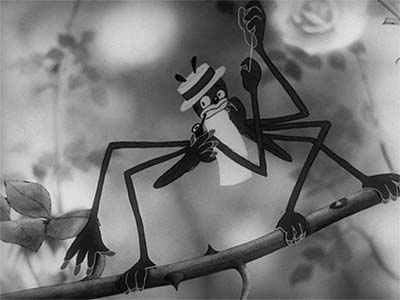
Kumo To Tulip![]()
Kenzo Masaoka / 1943
"Kumo To Tulip" was made by Kenzo Masaoka during World War II. Masaoka is regarded as one of the pioneers of Japanese animation, having directed the first Japanese sound cartoon in 1933. During his twenty year career, he directed over two dozen animated films, mostly based on fables and folklore. "Kumo To Tulip" was his masterpiece, exhibiting skillful technical effects as well as solid personality animation.
Of particular note is the beautiful effects animation- wind, rain, fire and smoke- all done in a unique, keenly observed style. The contrast in the way the spider and the ladybug move is also impressive. If you look carefully, you’ll see that the backgrounds incorporate photographs and there are several very long camera moves that must have necessitated match cuts or dissolves to accomplish. The film evokes a gentle mood, quite contrary to the spirit of other Wartime films.
Click to access the…
Downloads expire after August 2024
If you are currently on a quarterly membership plan, consider upgrading to an annual membership to get access to our bonus page with even more downloads. If you still have time on you quarterly membership when you upgrade to an annual membership, email us at…
membership@animationresources.org
…and we will credit your membership with the additional time. These bonus downloads expire after September 1st, 2024.
JOIN TODAY To Access Members Only Content
Whew! That is an amazing collection of treasures! The most important information isn’t what you already know… It’s the information you should know about, but don’t know yet. We bring that to you every other month.
THIS IS JUST THE TIP OF THE ICEBERG!
Animation Resources has been sharing treasures from the Animation Archive with its members for over a decade. Every other month, our members get access to a downloadable Reference Pack, full of information, inspiration and animation. The RefPacks consist of e-books jam packed with high resolution scans of great art, still framable animated films from around the world, documentaries, podcasts, seminars and MORE! The best part is that all of this material has been selected and curated by our Board of professionals to aid you in your self study. Our goal is to help you be a greater artist. Why wouldn’t you want to be a member of a group like that?
Membership comes in three levels. General Members get access to a bi-monthly Reference Pack as well as a Bonus RefPack from past offerings in the in-between months. We offer a discounted Student Membership for full time students and educators. And if you want to try out being a member, there is a Quarterly Membership that runs for three months.
JOIN TODAY!
https://animationresources.org/membership/levels/
FREE SAMPLES!
Not Convinced Yet? Check out this SAMPLE REFERENCE PACK! It will give you a taste of what Animation Resources members get to download every other month! That’s 560 pages of great high resolution images and nearly an hour of rare animation available to everyone to download for FREE! https://animationresources.org/join-us-sample-reference-pack/
![]()
![]() Animation Resources depends on your contributions to support its projects. Even if you can’t afford to join our group right now, please click the button below to donate whatever you can afford using PayPal.
Animation Resources depends on your contributions to support its projects. Even if you can’t afford to join our group right now, please click the button below to donate whatever you can afford using PayPal.
















